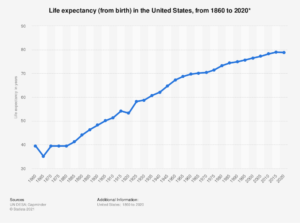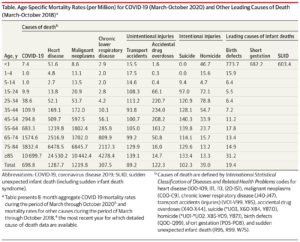In the century from 1920 to 2020 the average life span doubled from 53.22 years to 78.81 years. The Covid-19 pandemic put the brakes on that.
In a newly published report from the National Center for Health Statistics (NCHS), a division of the CDC (Center for Disease Control and Prevention), overall life expectancy dropped from 78.8 years estimated in 2019 to 77.8 years currently; a decrease of an entire year. The changes were greater among Hispanic and African Americans.
It was big news among academics who track this sort of thing when between the years 2014 – 2015 U.S. life expectancy dropped by 0.2 years after decades of increases.
The sad result of Covid-19 is that US life expectancy has to be revised downward by a whole year. But in context, as the Statistica.com chart graphically demonstrates, US life expectancy has been a startling success story. Interestingly, the most significant dips in the last 160 years were the result of Civil War (1860 – 1865) and the Spanish Flu epidemic (1919 – 1920).
Pasteurization, food safety, antibiotics, chlorination of drinking water, sanitation, and vaccines for childhood diseases like polio and smallpox made huge impacts on life expectancy. Huge advances in healthcare diagnosis and treatment have extended lives that would otherwise been ended by cancer, heart disease, and other fatal ailments.
JAMA chart of Age-specific mortality comparing Covid-19 to other leading causes of death.



